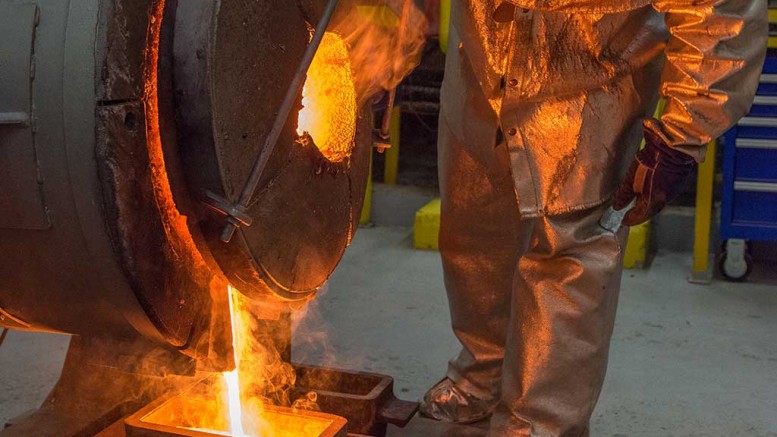The following are highlights from The Silver Institute’s 2016 Interim Silver Market Review. For more information, please visit www.silverinstitute.org.
The silver market is expected to be in an annual physical deficit of 52.2 million oz. in 2016, marking the fourth consecutive year in which the market has realized an annual physical shortfall. While such deficits do not necessarily influence prices in the near-term, multiple years of annual deficits can begin to apply upward pressure to prices in subsequent periods. This year, an expected 71.4 million oz. net inflow into exchange-traded product (ETP) holdings and a 61.9 million oz. derivatives exchange inventory build on a year-to-date basis (October-end) have increased the impact of the physical deficit, bringing the net balance to -185.5 million oz., or nine weeks of global demand. Above-ground stocks, including ETPs and exchange inventories, could reach 2,640 million oz. in 2016, in a 15% increase from the previous year.
Silver prices this year through Nov. 11 averaged US$17.23 per oz., which was 9.9% higher than in the same period in 2015. The GFMS team at Thomson Reuters forecasts silver prices will average US$17.15 per oz. for the full calendar year, in a 9.4% increase over the 2015 average.
Total silver supply is forecast to fall 3% to 1,012.4 million oz. in 2016. The decline would be driven by a 1% drop in mine production, a 0.3% fall in scrap supply and 20 million oz. in net de-hedging.
Mine production could reach 887.4 million oz. this year, which is almost 6 million oz. lower than 2015, and the second-highest year of production on record. Healthy increases in primary silver mine production, particularly in Peru, are being partly offset by losses in silver output from lead-zinc and gold mines. After four years of consecutive declines, scrap supply is contracting only marginally at 0.5 million oz., compared to 2015, which is a marked change from the 29 million oz. annual average decline recorded over the previous four years. Higher local silver prices have contributed to the improved sentiment.
Silver bullion coin and bar sales could contract 24% to 222 million oz. this year. Bullion silver coins are forecast to reach 122.7 million oz. in 2016, which is 7.9% below last year’s 133.2 million oz. record. The drop is unsurprising given the increase the year before, when investors entered the market en masse to bargain hunt after the silver price decline during second-half 2015. Physical bar demand could contract 38% this year to 99.3 million oz., driven by a lacklustre Chinese economy and weak consumer sentiment in North America. But demand in Europe should improve 14%, reaching 14.5 million oz. this year on the back of Brexit fears and a rising silver price. Physical bar and coin demand should account for 21% of physical demand in 2016, down from 25% in 2015 and up from just 5% a decade ago.
Silver demand from the photovoltaics industry is forecast to increase 11% to reach a record high of 83.3 million oz. this year. The rise is driven by global solar installations, which should reach 70 gigawatts in 2016. China accounts for 70% of these additions in solar installations. Solar will make up 14% of total industrial demand this year, which is flat compared to 2015, but up from just 1% a decade ago. Silver demand from ethylene oxide producers is predicted to stay flat this year at 10.2 million oz., after doubled demand last year. Of the annual total, 10% is replacement demand for existing capacity, whereas the rest represents a 6% rise in capacity additions, such as the Sadara project in Saudi Arabia. All other industrial sectors are expected to record minor losses in silver consumption this year, guided by challenging economic backdrops and thrifting and miniaturization trends in electronic applications. Total industrial demand for silver could decline 1% to 585.1 million oz., accounting for 55% of physical demand in 2016.
Jewellery fabrication is forecast to drop 8% to 208.5 million oz. in 2016. A decline in discretionary spending, thrifting, lower economic growth and a higher silver price have all contributed to the decline. In China, demand for high-purity silver bracelets is rising, however. Competition for low-end silver jewellery between smaller fabricators and branded outlets has intensified, weighing down on jewellers’ profitability. Jewellery demand in Asia is expected to contract 10% this year. North America mainly imports its silver jewellery, demand for which could slow this year, partly explained by continued trends towards yellow-coloured jewellery. North American domestic fabrication is set to reach 28.9 million oz., a 6% decline year-on-year.


Be the first to comment on "Facts ‘n’ Figures: Silver market to record fourth straight deficit in 2016"